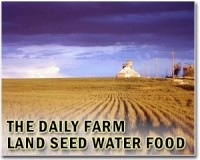 |
Madison WI (SPX) Aug 19, 2010 Greenhouse gas markets, where invisible gases are traded, must seem like black boxes to most people. Farmers can make money on these markets, such as the Chicago Climate Exchange, by installing methane capture technologies in animal-based systems, no-till farming, establishing grasslands, and planting trees. Farmers, students, extension educators, offset aggregators, and other stakeholders need to understand how to change farming practices to maximize their potential economic returns in these new markets. To open the black box, researchers at the W.K. Kellogg Biological Station, including Claire P. McSwiney, Sven Bohm, Peter R. Grace, and G. Philip Robertson, developed the Farming Systems Greenhouse Gas Emissions Calculator, a simple web-based tool to help users make economically and environmentally sound decisions. The first page of the calculator asks users to choose a county of interest from anywhere in the US. An input/output window allows them to choose which crops they will grow, yields, tillage practices, and nitrogen fertilizer rates. Default values based on localized USDA statistics are provided as a starting point. Given the farming practices chosen, the calculator tells the user how much carbon was stored in the soil or lost to the atmosphere, nitrous oxide (a greenhouse gas 300 times more potent than carbon dioxide) lost from the soil in response to fertilizer application, carbon dioxide produced by tractors, and carbon dioxide produced in manufacturing the fertilizer. In an article in the 2010 Journal of Natural Resources and Life Science Education, published by the American Society of Agronomy, the Crop Science Society of America, and the Soil Science Society of America, the authors used the calculator to demonstrate how tillage compares with no-till in a three-year rotation of corn, soybean, and wheat. Whether tilled or untilled, corn years always had the largest greenhouse gas losses due to large fertilizer additions. Wheat requires less fertilizer and soybeans require none. No-till management reduced greenhouse gas emissions by 50% due to soil carbon storage. In another comparison, the amount of fertilizer applied was changed from 134 to 101 kg. Such a reduction could be achieved without a yield penalty by more precisely applying fertilizers or by using new fertilizer recommendations. Excess nitrogen in soil is readily transformed to nitrous oxide. By simply reducing fertilizer applications, the cropping system reduced greenhouse gas emissions 12%. In an Environmental Science class at Kalamazoo College, the authors used the calculator for an in-class exercise. Using the farming systems calculator allowed students to take control and make the management changes they had been discussing for weeks. By making the management decisions themselves and 'seeing' what happened to soil carbon, the connections between changes in farm practices and the potential for economic gain became much clearer. Farmers and other agricultural professionals can use the program to participate in similar exercises. By comparing different cropping scenarios against one another, the practices with the most promise for mitigating atmospheric greenhouse gas concentrations become readily apparent. Those not familiar with agriculture learn how certain farming practices can have a positive environmental impact.
Share This Article With Planet Earth
Related Links American Society of Agronomy (ASA) greenhouse gas calculator Farming Today - Suppliers and Technology
 Ukraine to limit grain exports due to drought: official
Ukraine to limit grain exports due to drought: officialKiev (AFP) Aug 17, 2010 Ukraine is impose a cap on wheat and barley exports until the end of the year due a severe drought, officials said on Tuesday, after a full ban by Russia triggered concern on global grain supplies. Ukraine will export a maximum of 3.5 million tonnes of wheat and barely until the end of the calendar year, the agriculture ministry said, barely half of what it exported last year in the same sea ... read more |
|
| The content herein, unless otherwise known to be public domain, are Copyright 1995-2010 - SpaceDaily. AFP and UPI Wire Stories are copyright Agence France-Presse and United Press International. ESA Portal Reports are copyright European Space Agency. All NASA sourced material is public domain. Additional copyrights may apply in whole or part to other bona fide parties. Advertising does not imply endorsement,agreement or approval of any opinions, statements or information provided by SpaceDaily on any Web page published or hosted by SpaceDaily. Privacy Statement |